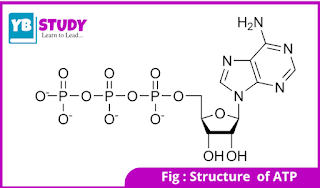What is ATP in Biology ?
What is ATP in Biology ?
- ATP stands for adenosine triphosphate, which is a biomolecule that is formed by the combination of three components a purine base (adenine), a sugar molecule (ribose), and three phosphate groups.
- Its main function is to store energy within the cell. This energy is released through a hydrolysis reaction, catalyzed by an enzyme called ATP hydrolase, in which ATP is decomposed in ADP (adenosine diphosphate) and Pi (phosphate).
- ATP (adenosine triphosphate) is the most common and universal energy-rich intermediate.
- As its name indicates, it is made up of an adenosine group (adenine + ribose) and a triphosphate group.
- The main characteristic is that the phosphate groups of ATP are that the three phosphate units electrostatically repel each other because the phosphorous atoms are positively charged and the oxygen atoms negatively.
What is the function of ATP?
- The main function of ATP is to serve as an energy supply in the biochemical reactions that take place inside the cell to maintain its active functions such as the synthesis of DNA and RNA, proteins, and the transport of certain molecules through the cell membrane.
- ATP plays an important role in the transport of macromolecules such as lipids and proteins inside and outside of the cell. Generally, this process is called as Active transport.
- ATP provides energy to the flagella, chromosomes, sperm to maintain their appropriate functioning.
- ATP is very important for the muscles contraction it binds to the myosin to provide energy and facilitate its binding to actin to form a cross-bridge.
How does ATP store energy?
To keep phosphates together in a triphosphate group, a lot of energy is needed, specifically 7.7 kcal of free energy per mole of ATP, which is the same amount of energy that is released when ATP is hydrolyzed to ADP and inorganic phosphate.
In the case of ATP, energy is stored in the bond that holds the phosphate molecules together, which are pyrophosphate bonds, also called anhydride bonds or high-energy bonds.
How does ATP give up energy?
ATP gives its high-energy terminal phosphate group to a large number of acceptor molecules such as sugars, amino acids, and nucleotides. When ATP gives up its terminal group it becomes ADP (adenosine diphosphate) and releases a phosphate group that binds to the acceptor molecule. This process is called phosphate group transfer or phosphorylation, not to be confused with oxidative phosphorylation that forms ATP.
Phosphorylation increases the free energy level of the acceptor molecule and thus can react exergonically in enzyme-catalyzed biochemical reactions.
A reaction is exergonic when the variation of the Gibbs free energy (ΔG is negative). The ΔG of ATP hydrolysis or phosphate group transfer is -7.7 kcal.
ATP can also release energy through hydrolysis. The water molecule attacks one of the bonds between the phosphate groups to give either a phosphate group and ADP, or pyrophosphate (made up of two phosphate groups) and AMP.
How ATP is Produced?
- ATP is produced by cellular respiration through the electron transport chain is the main source of ATP creation as well as photosynthesis in plants.
- ATP is also created during glycolysis and during the citric acid cycle.
- The formation of ATP is carried out by the phosphorylation of ADP thanks to the action of arginine phosphate and creatine phosphate that act as special reserves of chemical energy for the rapid phosphorylation of ADP. This process is known as oxidative phosphorylation.
- Both creatine phosphate and arginine phosphate are known as phosphagens, and the enzyme transphosphorylase is involved in the reaction.
- As a curiosity, while creatine phosphate is only found in vertebrates, in invertebrates, arginine phosphate is the most frequent.

